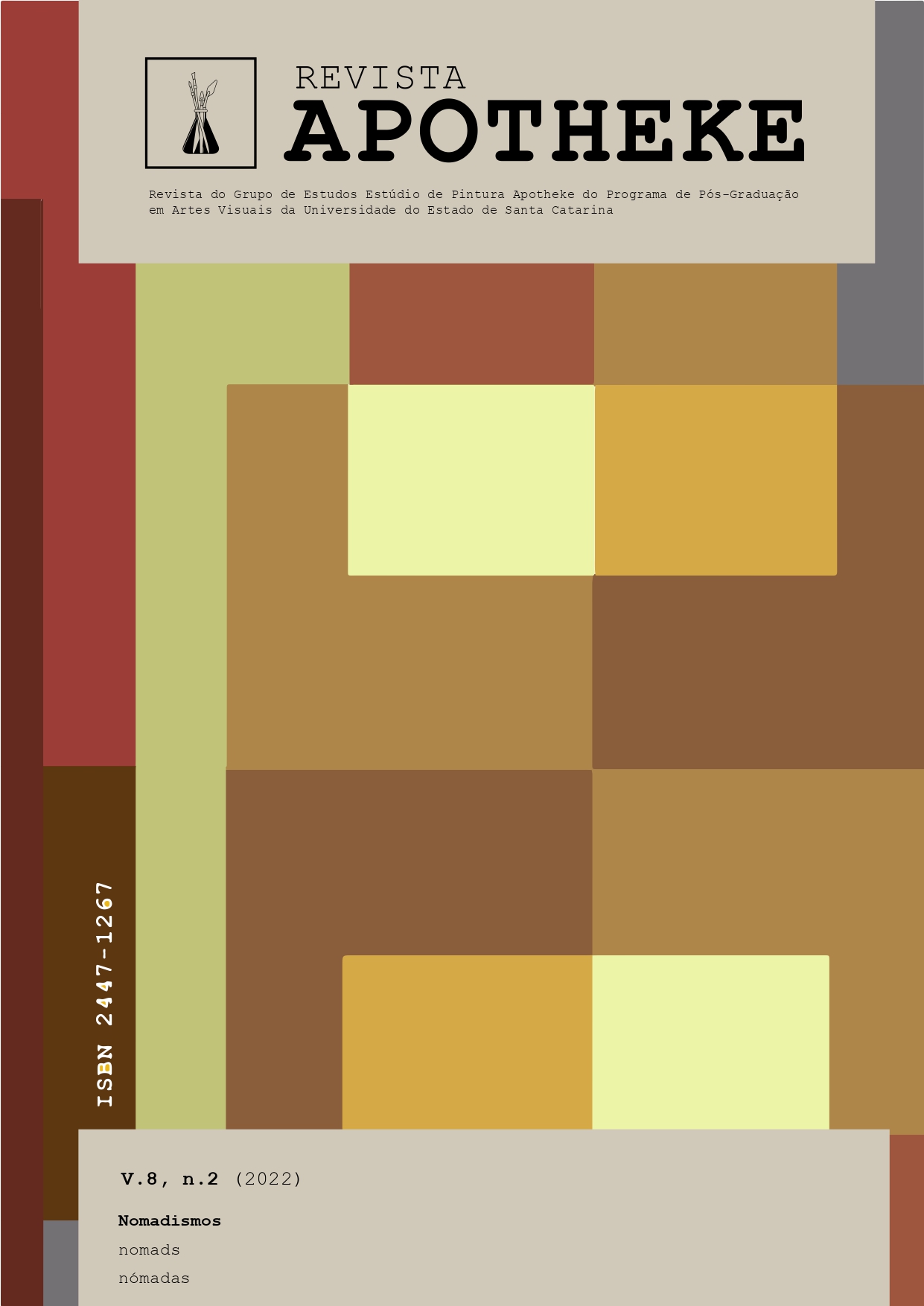Simulation of narrative trajectory between cities and other notes in transit
DOI:
https://doi.org/10.5965/24471267822022231Keywords:
displacement, narrative, personal archive, rearrangement, routeAbstract
For the master’s research at PPGARTES-UFC, I used the time frame from 2018 to 2020 to delimit my collection of archived documents to be reviewed and post-produced for artistic creation. I justify the choice of clipping and describe situations, self-analysis and memories of that specific period. Using techniques such as pattern identification, filtering and grouping to rearrange data from my daily life, I propose the autofictional persona Amari, for which, in this text, I present the narrative trajectory: a journey between cities and modes of transport. To deal with the encounter and the relationships between elements (tangible and intangible), I use the network image (in different technological approaches) and adopt the thoughts of Ingold (2015) on pilgrimage and ways of knowing. Through five reports of personal experiences, I simulate crisis scenarios, expose the process and seek to communicate the context (the vision) in which this research arises and develops. Finally, this article reflects on nomadism in territories, in fields of knowledge and in human interaction with the digital.
Downloads
References
BEIGUELMAN, Giselle. Políticas da imagem: vigilância e resistências na dadosfera. - São Paulo: Ubu Editora, 2021.
BENSUSAN, Nurit. Do que é feito o encontro. Ilustrações de Ana Cartaxo. — Brasília, DF : IEB Mil Folhas, 2019.
CARERI, Francesco. Walkscapes: o caminhar como prática estética; prefácio de Paola Berenstein Jacques; tradução Frederico Bonaldo. — I. ed. — São Paulo : Editora G. Gili, 2013.
CONSIGLIO, Sonia. Por que assistentes virtuais são mulheres?. VALOR INVESTE, 4 de maio de 2021. Disponível em: https://valorinveste.globo.com/blogs/sonia-favaretto/post/2021/05/por- que-assistentes-virtuais-sao-mulheres.ghtml. Acesso em: 01, jun. 2022.
DIAMOND, Sara. Visualização de dados: materialidade e mediação [2011]. In: KOSMINSKY, Doris; CASTRO, Barbara; LUDWIG, Luiz. Existência Numérica - 1a ed. - Rio de Janeiro : Rio Book’s, 2018. p. 57 - 63.
FLUSSER, Vilém. O universo das imagens técnicas: Elogio da superficialidade. - São Paulo : Annablume, 2008.
FROEN, Jonathan Safran. Aqui estou. — Editora Rocco, 2017.
HAN, Byung-Chul. Sociedade da transparência ; tradução de Enio Paulo Giachini. - Petrópolis, RJ : Vozes, 2017.
INGOLD, Tim. Estar vivo: ensaios sobre movimento, conhecimento e descrição. Tradução de Fábio Credes. - Petrópolis, RJ: Vozes, 2015.
MACHADO, Arlindo. Máquina e imaginário: o desafio das poéticas tecnológicas. São Paulo: EdUSP, 1993.
MANOVICH, Lev. Introduction to Info-Aesthetics (2008). Disponível em: http://manovich.net/content/04-projects/060-introduction-to-info-aesthetics/57-article-2008.pdf. Acesso em: 19, jul. 2022.
MANOVICH, Lev. Database as a symbolic form (1998). Disponível em: http://manovich.net/content/04-projects/022-database-as-a-symbolic-form/19_article_1998.pdf. Acesso em: 10, maio de 2021.
ROMAGNOLI, Gabriele. Solo bagaglio a mano. — Feltrinelli, 2015.
SALLES, Cecília Almeida. Redes da Criação: Construção da Obra de Arte. São Paulo: Editora Horizonte, 2006.
VENTURELLI Suzete., & Melo, M. A. de. (2019). O visível do invisível: data art e visualização de dados. ARS (São Paulo), 17(35), 203 - 214. https://doi.org/10.11606/
VENTURELLI, Suzete. Arte: espaço_tempo_imagem. Brasília: Editora Universidade de Brasília, 2011.
VIANNA, Fernando Ressetti Pinheiro Marques. Se os dados são o novo petróleo, onde estão os royalties? O neoliberalismo na era dos dados. Revista Gestão & Conexões. Vitória (ES), v. 10, n. 3, set/dez 2021.
WASSERMAN, Stanley; FAUST, Katherine. Social Network Analysis: Methods and Applications. Cambridge University Press, 2004.
WURMAN, Richard Saul. Ansiedade da informação: como transformar informação em compreensão. São Paulo: Cultura Editores Associados, 1991.
Downloads
Published
How to Cite
Issue
Section
License
Copyright (c) 2022 Ariane Mendes, João Vilnei Oliveira Filho

This work is licensed under a Creative Commons Attribution-NonCommercial 4.0 International License.
Copyright and Licensing Policy
Authors of works submitted to Revista APOTHEKE authorize their publication in both print and digital formats exclusively for academic purposes. Reproduction is permitted, provided that the source is properly cited. Authors confirm the originality, authorship, and unpublished status of their manuscripts.
Articles published by the journal are freely available and intended for academic and non-commercial use only. All copyrights are transferred to the journal. The content of signed articles reflects the views of their respective authors and not the official position of Revista Apotheke. The author(s) agree to always cite the following reference when republishing or referring to the content originally published in Revista Apotheke:
“This article was originally published by Revista Apotheke in volume (insert volume), number (insert number), year (insert year), and is available at: http://www.revistas.udesc.br/index.php/APOTHEKE/index”
It is the sole responsibility of the authors to obtain written permission for the use of any material protected by copyright law included in their articles. Revista Apotheke is not responsible for copyright infringements committed by contributors.
Authors retain copyright and grant the journal the right of first publication, with the work licensed under a Creative Commons Attribution-NonCommercial License (CC BY-NC):
-
Attribution (BY): Licensees are allowed to copy, distribute, display, perform, and create derivative works, provided that proper credit is given to the author or licensor, in the manner specified.
-
NonCommercial (NC): Licensees may use the material only for non-commercial purposes.
After publication, authors retain the rights to their work and may republish the text.



